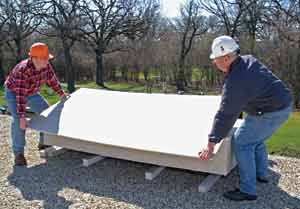Low-Slope Commercial Roofing
Events of the 1980s
Two significant events occurred in the 1980s that further advanced the use of cover boards.
- The determination that application of hot asphalt or coal tar directly over foamed insulation could result in blistering2.
- A change to Factory Mutual (recently renamed FM Global) Standard 4470 requiring that all insulation be mechanically attached to the steel deck substrate prior to the application of an FM-approved roof assembly.
Significantly, the use of mechanical fasteners and stress plates creates thermal shorts within the insulation. In colder climates, interior condensation forms when the warmer air around the metal fasteners is cooled by the colder exterior temperatures, resulting in moisture formation on the fasteners. The condensed moisture then drips into the interior and rusts the interior components of the screw.
|
||||||||||||||
This problem was solved in a variety of creative ways, such as recessing the screws into the stress plate hub, the use of plastic fasteners and the application of a cover board over the foamed insulation to act as a thermal break between the cold exterior and the warm interior.
As a result of these developments, cover boards became a standard component in commercial roof assemblies. In addition, competing board manufacturers began to promote the use of particular cover board types for their abilities to enhance the performance of specific roof systems.
Comprehensive rounds of wind uplift and fire testing have confirmed the claims of better performance characteristics with the use of some cover boards. Some new cover board materials, including oriented strand board (OSB) and water-resistant gypsum board, entered the market and further broadened the options of interface materials. Materials less than 1/2-inch thick also became available, some of which offer performance characteristics similar to boards with twice their thickness. These options were particularly economical when adhered with hot asphalt or cold adhesive.










